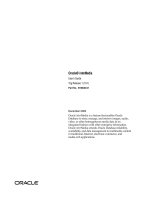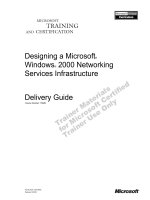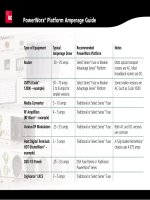Tài liệu Designing Business - Delivery Guide ppt
Bạn đang xem bản rút gọn của tài liệu. Xem và tải ngay bản đầy đủ của tài liệu tại đây (289.66 KB, 12 trang )
Course Number: 1608A
Developed with KiZAN Corporation
1099 Part No. X04-99417
Delivery Guide
Designing Business
Solutions
Information in this document is subject to change without notice. The names of companies,
products, people, characters, and/or data mentioned herein are fictitious and are in no way intended
to represent any real individual, company, product, or event, unless otherwise noted. Complying
with all applicable copyright laws is the responsibility of the user. No part of this document may
be reproduced or transmitted in any form or by any means, electronic or mechanical, for any
purpose, without the express written permission of Microsoft Corporation. If, however, your only
means of access is electronic, permission to print one copy is hereby granted.
Microsoft may have patents, patent applications, trademarks, copyrights, or other intellectual
property rights covering subject matter in this document. Except as expressly provided in any
written license agreement from Microsoft, the furnishing of this document does not give you any
license to these patents, trademarks, copyrights, or other intellectual property.
1999 Microsoft Corporation. All rights reserved.
Microsoft, MS-DOS, Windows, Windows NT, Win32, Active Directory, ActiveX, Expedia,
FrontPage, Intellisense, J/Direct, JScript, Outlook, PowerPoint, Rushmore, SQL Server, Visual
Basic, Visual C++, Visual FoxPro, Visual InterDev, Visual J++, Visual SourceSafe, and Visual
Studio are either registered trademarks or trademarks of Microsoft Corporation in the U.S.A.
and/or other countries.
The names of companies, products, people, characters, and/or data mentioned herein are fictitious
and are in no way intended to represent any real individual, company, product, or event, unless
otherwise noted.
Other product and company names mentioned herein may be the trademarks of their respective
owners.
Project Lead: Michas Sadzak
Instructional Designers: Shawn Lock, Michas Sadzak
Program Managers: Mark Bader, Rama Biswas, Teresa Canady
Subject Matter Experts: Mark Bader, Rod Fergusson, Michas Sadzak, Scott F. Wilson (KiZAN
Corporation)
Graphic Artist: Elizabeth Johanson (ArtSource, Inc.)
Editors: Todd Duft (Write Stuff), Joe Feese (Write Stuff)
Production Support: Marlene Lambert (Online Training Solutions, Inc.)
Manufacturing Support: Julie Challenger, John Williams
Product Manager: Ron Wodaski
Business Manager: Roger Gerdes
Authors: Rod Fergusson, John Ross (KiZAN Corporation), Michas Sadzak, Scott F. Wilson
(KiZAN Corporation)
Course Number: 1608A
1099 Part No. X04-99417
Contents iii
Contents
About This Course
Course Overview.................................................................................................. xiii
Course Timing....................................................................................................... xv
Document Conventions......................................................................................... xx
Introduction
Introductions ........................................................................................................... 3
Course Materials ..................................................................................................... 4
Prerequisites............................................................................................................ 5
Microsoft Certified Professional Program .............................................................. 6
Facilities.................................................................................................................. 7
Module 1: Course Overview
Module Overview ................................................................................................. 10
Overview............................................................................................................... 11
Business Solutions Design Curriculum................................................................. 12
Curriculum Vision and Purpose....................................................................... 13
Courses in the Curriculum ............................................................................... 14
Curriculum Case Study.................................................................................... 15
Overview of This Course ...................................................................................... 16
Course Vision and Purpose.............................................................................. 18
Course Objectives ............................................................................................ 19
Modules in This Course................................................................................... 21
Modules in This Course (continued)................................................................ 22
Activity 1.1: Identifying Design Steps.................................................................. 23
Project Life Cycle ................................................................................................. 24
Life Cycle Models............................................................................................ 25
MSF Process Model for Application Development ......................................... 26
This Course and the MSF Process Model........................................................ 27
Looking Forward................................................................................................... 28
Module 2: Solution Design Using the MSF
Module overview .................................................................................................. 30
Overview............................................................................................................... 31
Design Overview................................................................................................... 32
Business Solution Design ................................................................................ 33
A Well-Designed Solution............................................................................... 34
Cost of Fixing a Poorly Designed Solution ..................................................... 35
Cost of Not Fixing a Poorly Designed Solution............................................... 36
Activity 2.1: Identifying Design Principles........................................................... 37
MSF Design Process ............................................................................................. 38
Three Phases of Design.................................................................................... 39
Conceptual Design........................................................................................... 40
Logical Design................................................................................................. 41
Physical Design................................................................................................ 42
Relationship Among Design Phases ................................................................ 43
Design Phases in MSF Process Model............................................................. 44
Activity 2.2: Identifying Design Phases................................................................ 45
Benefits of the MSF Design Process..................................................................... 46
iv Contents
Consensus of Design........................................................................................ 47
Completeness of Design .................................................................................. 48
Traceability of Design...................................................................................... 49
Flexibility of Design ........................................................................................ 50
Review .................................................................................................................. 51
Guidelines ........................................................................................................ 52
Review Questions ............................................................................................ 53
Looking Forward ............................................................................................. 54
Module 3: Services-Based Approach to Solution Design
Module Overview ................................................................................................. 56
Overview............................................................................................................... 57
Services-Based Approach ..................................................................................... 58
Definition of an Application Model................................................................. 59
MSF Application Model .................................................................................. 60
Definition of a Service..................................................................................... 61
User Services ................................................................................................... 62
Business Services............................................................................................. 63
Data Services ................................................................................................... 64
Examples of Services....................................................................................... 65
Services-Based Application............................................................................. 66
Activity 3.1: Identifying Services ......................................................................... 67
Value of a Services-Based Approach.................................................................... 68
Reusability ....................................................................................................... 69
Flexibility of Distribution ................................................................................ 70
Parallelism in the Development Effort............................................................. 71
Other Benefits.................................................................................................. 72
Review .................................................................................................................. 73
Guidelines ........................................................................................................ 74
Review Questions ............................................................................................ 75
Looking Forward ............................................................................................. 76
Module 4: Business Solution Conceptual Design
Module Overview ................................................................................................. 78
Overview............................................................................................................... 79
Conceptual Design Basics..................................................................................... 80
Conceptual Design in the Design Process........................................................ 81
Conceptual Design: The Search for Meaning .................................................. 82
Goals of Conceptual Design ............................................................................ 83
Perspective of Conceptual Design ................................................................... 84
Perspective Captured in Usage Scenarios........................................................ 85
Clarifying Conceptual Design.......................................................................... 86
Value of Conceptual Design ............................................................................ 87
Activity 4.1: Risks of Skipping Conceptual Design.............................................. 88
Conceptual Design Process................................................................................... 89
Conceptual Design and the MSF Process Model............................................. 90
Conceptual Design Steps ................................................................................. 91
Deliverables of Conceptual Design.................................................................. 92
Conceptual Design Research................................................................................. 93
Deliverables of the Research Baseline............................................................. 94
Contents v
Researching the Enterprise Architecture.......................................................... 95
Researching Business Processes and Activities ............................................... 96
Prioritizing Business Processes and Activities ................................................ 97
Researching Business Systems and Users ....................................................... 98
Gathering Requirements and Constraints ........................................................ 99
Activity 4.2: Inputs to Conceptual Design .......................................................... 100
Conceptual Design Analysis ............................................................................... 101
Deliverables of the Analysis Baseline ........................................................... 102
Synthesizing Business and User Information ................................................ 103
Example: Workflow Process Model .............................................................. 104
Example: System-Use Case Model................................................................ 105
Example: User-Use Case Model.................................................................... 106
Current-State Usage Scenarios....................................................................... 107
Example: Current-State Usage Scenario........................................................ 108
Documenting the Current State...................................................................... 109
Activity 4.3: Value of Information Models......................................................... 110
Conceptual Design Optimization ........................................................................ 111
Deliverables of the Optimization Baseline .................................................... 112
Designing the Desired Future State ............................................................... 113
Redesigning the Process ................................................................................ 114
Value of the Redesigned Process ................................................................... 115
Describing the Desired Future State .............................................................. 116
Optimization and Validation Steps ................................................................ 117
Future-State Usage Scenario Validation ........................................................ 118
Activity 4.4: Creating a Future-State Usage Scenario ........................................ 119
Review ................................................................................................................ 120
Guidelines ...................................................................................................... 121
Review Questions .......................................................................................... 122
Looking Forward ........................................................................................... 123
Module 5: Business Solution Logical Design
Module Overview ............................................................................................... 126
Overview............................................................................................................. 127
Logical Design Basics......................................................................................... 128
Logical Design in the Design Process............................................................ 129
Logical Design: The Search for Organization ............................................... 130
Goals of Logical Design ................................................................................ 131
Perspective of Logical Design ....................................................................... 132
Perspective Captured in Business Object Models.......................................... 133
Clarifying Logical Design.............................................................................. 134
Value of Logical Design ................................................................................ 135
Activity 5.1: Risks of Skipping Logical Design.................................................. 136
Logical Design Process....................................................................................... 137
Logical Design and the MSF Process Model................................................. 138
Logical Design Steps ..................................................................................... 139
Deliverables of Logical Design...................................................................... 140
Analysis: Business Objects and Services............................................................ 141
Deliverables of the Analysis Baseline: Part 1................................................ 142
Business Objects ............................................................................................ 143









